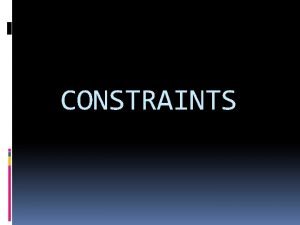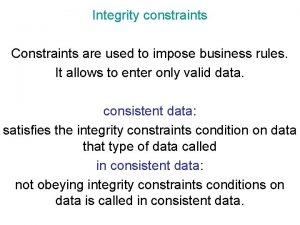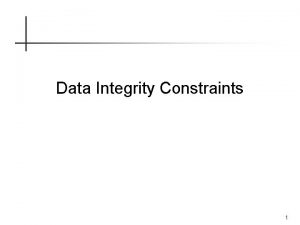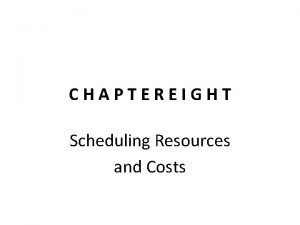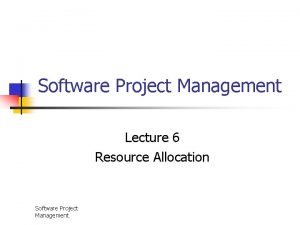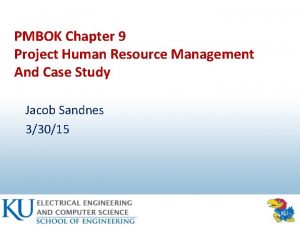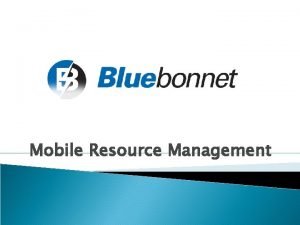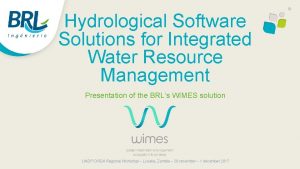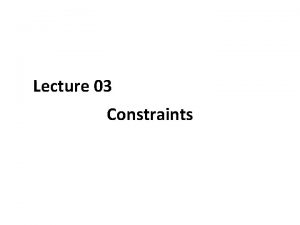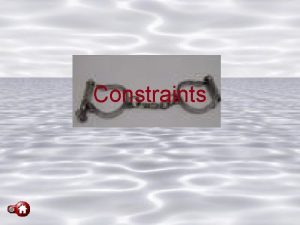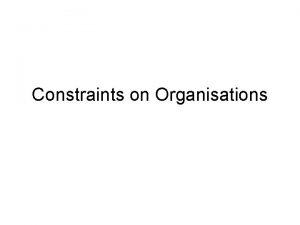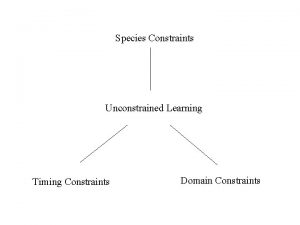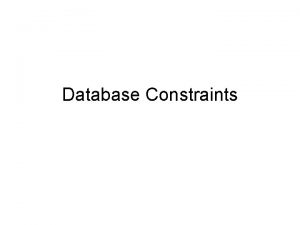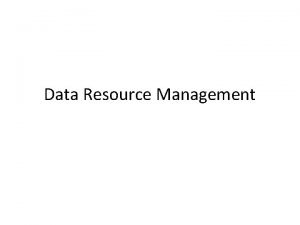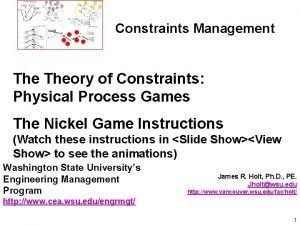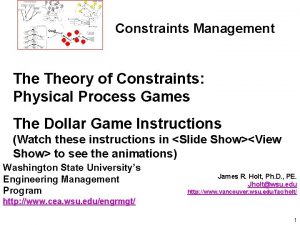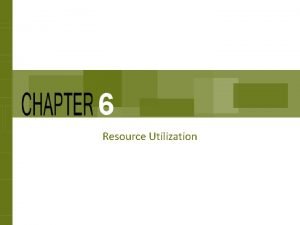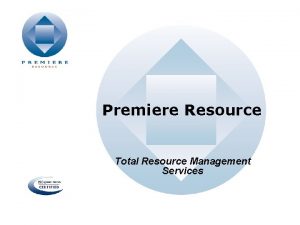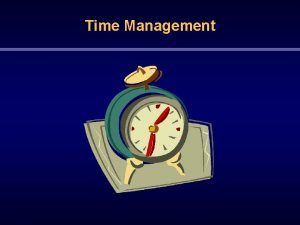Resource Management Types of Constraints q Time q




























- Slides: 28

Resource Management

Types of Constraints q Time q Resource q Mixed Copyright © 2010 Pearson Education, Inc. Publishing as Prentice Hall 12 -2

Resources • Definition: anything that is scarce and required for any activity in the project. Resources are constraints for the project. • Resources can be: – Non-storable: has to be renewed for each period e. g. work – Storable: depleted only by usage (remains available if not used) e. g. money • The most common resource typology, the 4 Ms: – – – Men Machines Money (cost) Material Other

Loading (resource allocation) • The assignment of work to an worker, machine or unit (generally: to a workstation) in time. • A workstation can be: – underloaded (load < capacity) – fully loaded (load = capacity) – overloaded (load > capacity) • Fully loading is nearly impossible to reach except in flow production. • Underloading is the most common, because it respects time. Overloading leads to be late.

Resource Loading The amounts of individual resources that a schedule requires during specific time periods. Resource loading table Resource Name Tom Assign Bids Jeff Work 40 hrs Details 5/5 5/12 5/19 5/26 Work 8 h 32 h Calculate Cost Sue Select Bid Carol PR Campaign 40 hrs 8 hrs Work Work Copyright © 2010 Pearson Education, Inc. Publishing as Prentice Hall 8 h 8 h 8 h 32 h 32 h 8 h 8 h 12 -5

What to do with non-linear durationresource functions? • Use a computer • Focus on quasi-linear parts of the functions

Resource Leveling (Smoothing) A multivariate, combinatorial problem Objectives • To determine the resource requirements so that they will be available at the right time • To allow each activity to be scheduled with the smoothest possible transition across resource usage levels Copyright © 2010 Pearson Education, Inc. Publishing as Prentice Hall 12 -7

Prioritization Rules for Leveling v Smallest amount of slack v Smallest duration v Lowest ID number v Greatest number of successor v Requiring the most tasks resources Copyright © 2010 Pearson Education, Inc. Publishing as Prentice Hall 12 -8

General Procedure for Leveling 1. Create a project activity precedence table and network diagram, 2. Develop resource loading tables and a resource profile 3. Determine activity late finish times 4. Identify resource over allocation 5. Level the resource loading table 6. Recalculate net activity slacks and project delay Copyright © 2010 Pearson Education, Inc. Publishing as Prentice Hall 12 -9

Creating Resource Loading Charts (1/4) Display the amount of resources required as a function of time. 4 B 5 Res = 2 0 A 4 Res = 6 5 D 9 Res = 7 9 E 11 Res = 3 1. Start with a network diagram 4 C 7 Res = 2 Copyright © 2010 Pearson Education, Inc. Publishing as Prentice Hall 11 F 12 Res = 6 12 -10

Creating Resource Loading Charts 2/4 Activity Resource Duration A 6 4 B 2 1 C 2 3 D E F 7 3 6 4 2 1 ES 0 4 4 Slack 0 0 4 LF 4 5 11 5 9 11 0 0 0 9 11 12 2. Produce a table that shows the duration, early start, late finish, slack, and resource(s) required for each activity. Copyright © 2010 Pearson Education, Inc. Publishing as Prentice Hall 12 -11

Creating Resource Loading Charts 3/4 3. Draw an initial loading chart with each activity scheduled at its ES. Resources 8 6 4 A D B 2 C 2 4 F Resource imbalance E 6 8 10 12 Project Days Copyright © 2010 Pearson Education, Inc. Publishing as Prentice Hall 14 12 -12

Creating Resource Loading Charts 4/4 4. Rearrange activities within their slack to create a more level profile. Splitting C creates a more level project. Resources 8 6 4 A B 2 C 2 4 D C F E 6 8 10 12 Project Days Copyright © 2010 Pearson Education, Inc. Publishing as Prentice Hall 14 12 -13

Key Parameters in Multi-Project Environments Ø Schedule slippage Ø Resource utilization Ø In-process inventory Copyright © 2010 Pearson Education, Inc. Publishing as Prentice Hall 12 -14

Prioritizing Resource Allocations in Multi-Project Environments • First come first served • Greatest resource demand • Greatest resource utilization • Minimum late finish time • Mathematical programming Copyright © 2010 Pearson Education, Inc. Publishing as Prentice Hall 12 -15

Problem solving

Network with single resource data 0 2 0 0 0 0 2 a (1) 2 2 0 0 5 5 5 b (4) 5 10 c (3) 8 10 3 5 0 10 0 2 START (0) 0 2 0 5 3 7 d (2) 5 10 10 10 0 13 e (1) 3 13 0 13 FINISH (0) 13 0 13

Aggregation with a bar chart (single resource, earliest start) activity 1 2 3 4 5 a 1 1 b 4 4 6 7 8 9 10 4 4 4 c 3 3 3 3 d 2 2 2 e 11 12 13 1 1 1 Res. aggr. 5 5 9 9 9 5 5 3 3 3 1 1 1 Cum. res. 5 10 19 28 37 42 47 50 53 56 57 58 59 1 2 3 4 5 6 7 8 9 10 11 12 13 Resource units 11 10 9 8 7 6 5 4 3 2 1 Time

Aggregation with a bar chart (single resource, latest start) activity 1 2 a 1 1 3 4 5 b c 3 3 3 d 6 7 8 9 10 4 4 4 3 3 3 2 2 2 e 11 12 13 1 1 1 Res. aggr. 1 1 3 3 3 9 9 9 1 1 1 Cum. res. 1 2 5 8 11 20 29 38 47 56 57 58 59 1 2 3 4 5 6 7 8 9 10 11 12 13 Resource units 11 10 9 8 7 6 5 4 3 2 1 Time

The S Curve analysis • The minimum slope level is the less ‘critical’ from the viewpoint of availability

S Curve of the example

Other possibilities • Alternative resources • Alternative methods • Alternative sequences (if there is no technical dependency)

Levelling the load • We must have a starting allocation of activities over time and a resource constraint (previous example). Resource units 11 10 9 8 7 6 5 4 3 2 1 1 2 3 4 5 6 7 8 9 10 11 12 Time • Trying to keep the original TPT unchanged means that critical activities should not be moved. Thus try to move activities with free float. 13

Solution • There are only 2 activities with free float: b & d • Which one to move and to where? • Moving activity d 3 days in advance is eliminating the peak. Resource units 11 10 9 8 7 6 5 4 3 2 1 1 2 3 4 5 6 7 Time 8 9 10 11 12 13

Solution activity 1 2 3 4 5 a 1 1 b 4 4 6 7 8 9 10 4 4 4 c 3 3 3 3 d - - - 2 2 2 e 11 12 13 1 1 1 Res. aggr. 5 5 7 7 7 5 5 5 1 1 1 Cum. res. 5 10 17 24 31 36 41 46 51 56 57 58 59

S Curve

Effect of levelling • New „activity”: waiting for the resource (it is a lag, not a true activity) 0 2 0 0 0 0 2 a (1) 2 2 0 0 5 b (4) 5 5 c (3) 8 10 0 5 START (0) 0 2 0 5 0 10 d (2) 5 10 10 10 0 13 e (1) 3 13 0 13 FINISH (0) 13 • Changes: new precedence relationship, floats, late start and finish times 0 13

Optional homework • Hypothetical project resource analysis and planning (4*5 pts): – – Resource need per activity Loading chart Network diagram Smoothing with resource loading charts Copyright © 2010 Pearson Education, Inc. Publishing as Prentice Hall 12 -28
 Time management human resources
Time management human resources Scleronomic constraints are time dependent
Scleronomic constraints are time dependent Resource loading vs resource leveling
Resource loading vs resource leveling Contoh resource loading
Contoh resource loading Data integrity constraints are used to:
Data integrity constraints are used to: Biba n 445 ddl
Biba n 445 ddl Human resource management in retailing
Human resource management in retailing Role of personnel management
Role of personnel management Quadruple constraint
Quadruple constraint Quadruple constraints in project management
Quadruple constraints in project management Constraints on managers
Constraints on managers Quadruple constraint project management
Quadruple constraint project management Quadruple constraints in project management
Quadruple constraints in project management Cultural constraints on managers
Cultural constraints on managers What is elapsed time
What is elapsed time Scheduling resources and costs
Scheduling resources and costs Qv source
Qv source Storage resource management tool
Storage resource management tool Allocation management software
Allocation management software Microsoft project server resource management
Microsoft project server resource management Resource leveling
Resource leveling Project human resource management pmbok ppt
Project human resource management pmbok ppt Resource management pmbok
Resource management pmbok Mobile resource management solutions
Mobile resource management solutions Importance of hr management
Importance of hr management Recruitment process of max's restaurant
Recruitment process of max's restaurant Definition of hrm
Definition of hrm Induction in hrm
Induction in hrm Water resource management software
Water resource management software

